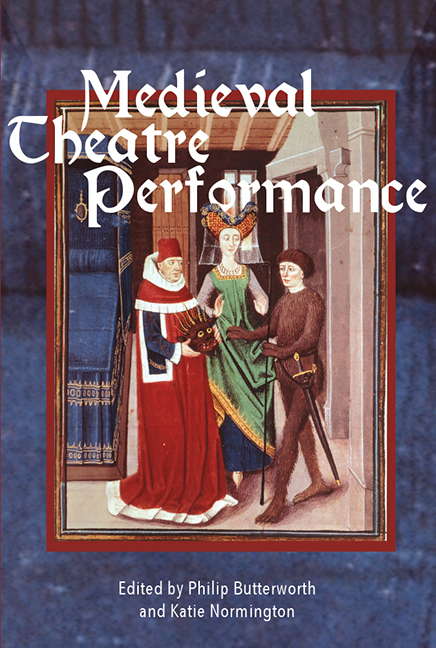Book contents
- Frontmatter
- Dedication
- Contents
- List of Illustrations
- Contributors
- Abbreviations of Principal Sources Cited
- Introduction
- Synopses
- 1 From Archive to Repertoire: The Disguising at Hertford and Performing Practices
- 2 Walk, Talk, Sit, Quit? On What Happens in Netherlandish Rhetoricians’ Plays
- 3 Performing Intrusions: Interaction and Interaxionality in Medieval English Theatre
- 4 Player Transformation: The Role of Clothing and Disguise
- 5 Pavilioned in Splendour: Performing Heaven in Fifteenth-Century Florence
- 6 Living Pictures: Drama without Text, Drama without Action
- 7 Performer-Audience Relationships in Fifteenth- and Sixteenth-century Danced Spectacles
- 8 Decadance in the Late Middle Ages: The Case of Choreomania
- 9 Writing, Telling and Showing Horsemanship in Rhetoricians’ Farce
- 10 Inanimate Performers: The Animation and Interpretive Versatility of the Palmesel
- 11 ‘lyke unto a lyvelye thyng’: The Boxley Rood of Grace and Medieval Performance
- 12 The Mechanycalle ‘Ymage off Seynt Iorge’ at St Botolph's, Billingsgate, 1474
- Bibliography
- Index
10 - Inanimate Performers: The Animation and Interpretive Versatility of the Palmesel
Published online by Cambridge University Press: 21 August 2018
- Frontmatter
- Dedication
- Contents
- List of Illustrations
- Contributors
- Abbreviations of Principal Sources Cited
- Introduction
- Synopses
- 1 From Archive to Repertoire: The Disguising at Hertford and Performing Practices
- 2 Walk, Talk, Sit, Quit? On What Happens in Netherlandish Rhetoricians’ Plays
- 3 Performing Intrusions: Interaction and Interaxionality in Medieval English Theatre
- 4 Player Transformation: The Role of Clothing and Disguise
- 5 Pavilioned in Splendour: Performing Heaven in Fifteenth-Century Florence
- 6 Living Pictures: Drama without Text, Drama without Action
- 7 Performer-Audience Relationships in Fifteenth- and Sixteenth-century Danced Spectacles
- 8 Decadance in the Late Middle Ages: The Case of Choreomania
- 9 Writing, Telling and Showing Horsemanship in Rhetoricians’ Farce
- 10 Inanimate Performers: The Animation and Interpretive Versatility of the Palmesel
- 11 ‘lyke unto a lyvelye thyng’: The Boxley Rood of Grace and Medieval Performance
- 12 The Mechanycalle ‘Ymage off Seynt Iorge’ at St Botolph's, Billingsgate, 1474
- Bibliography
- Index
Summary
On the second floor of the Chazen Museum of Art, on the campus of the University of Wisconsin-Madison, is a wooden sculpture of Christ on a donkey. About three-quarters life size, its exact provenance is unknown, but it is believed to have been made around 1450 somewhere in the Austrian Tyrol. Two other museums in the United States—the Detroit Institute of Arts and the Cloisters in New York—own such an image, both of which have also been dated to the fifteenth century, but are thought to be German in origin. Such sculpted wooden images of Christ on a donkey are generally known by their German name of Palmesel [palm donkey]. Palmesels can also be found in London's Victoria and Albert Museum and Paris's Musée National du Moyen Age. Many more reside in European museums and churches. I have seen Palmesels in Austria, France, Germany, Italy, Poland and Switzerland. Others, which I have not yet visited, are in Belgium, the Czech Republic and, outside Europe, in Bolivia and Paraguay.
A Palmesel in a museum can be misleading. It invites evaluation in terms of craftsmanship and aesthetics, and comparison to other wooden artworks of the period, often on view in the same room. But the Palmesel was not primarily an art object; it was—and still is, in some places—a partially animated dramatic participant in the processional theatre of Palm Sunday. Mounted on wheels and pulled over cobbles or other rough ground, the image shakes, joggling the figure of Christ and creating the impression that he is actively riding the donkey. The illusion can be enhanced by dressing Christ in a robe, placing a palm or olive branch in his left hand, and having him hold a loose set of reins attached to the donkey's head, such that these added props are ruffled, swayed or jiggled, not only by the jouncing but also by the breeze.
More importantly, the Palmesel—like any good actor—can play the Palm Sunday script in various ways. Just as a single Shakespearean role may be given widely differing interpretations by different actors, so the part of Christ entering Jerusalem on a donkey can be played differently in different places and at different times by Palmesels differing little in appearance, or by the same Palmesel directed in its dramatic participation by a later generation of local clergy and laity.
- Type
- Chapter
- Information
- Medieval Theatre PerformanceActors, Dancers, Automata and their Audiences, pp. 179 - 196Publisher: Boydell & BrewerPrint publication year: 2017

